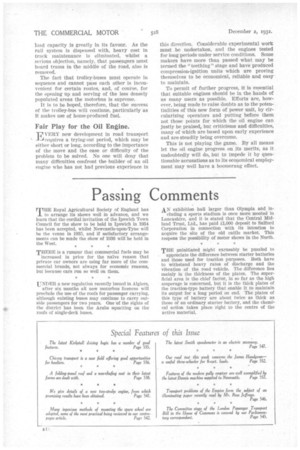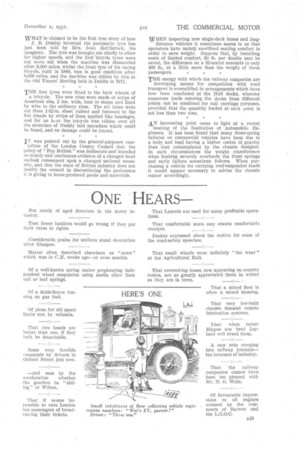Passing Comments
Page 36

Page 37

If you've noticed an error in this article please click here to report it so we can fix it.
THE Royal Agricultural Society of England has to arrange its shows well in advance, and we learn that the cordial invitation of the Ipswich Town Council for the show to be held in Ipswich in 1934 has been accepted, whilst Newcastle-upon-Tyne will be the venue in 1935, and if satisfactory arrangements can be made the show of 1936 will be held in the West.
THERE is a rumour that commercial fuels may he
increased hi price for the naive reason that private car owners are using far more of the commercial brands, not always for economic reasons, but because cars run so well on them.
UNDER a new regulation recently issued in Algiers, after six months all new motorbus licences will preclude the use of the roofs for passenger carrying, although existing buses may continue to carry outside passengers for two years. One of the sights of the district has been the Arabs squatting on the roofs of single-deck buses.
AN exhibition hall larger than Olympia and in
cluding a sports stadium is once more mooted in Lancashire, and it is stated that the Central Midland Trust, Ltd., has paid £1,000 deposit to Salford Corporation in connection with its intention to acquire the site of the old cattle market. This reopens the possibility of motor shows in the North.
THE uninitiated might excusably be puzzled to
appreciate the difference between starter batteries and those used for traction purposes. Both have to withstand heavy rates of discharge and the vibration of the road vehicle. The difference lies mainly in the thickness of the plates. The superficial area is the chief factor, in so far as the high amperage is concerned, but it is the thick plates of the traction-type battery that enable it to maintain its output for a long period on end. The plates of this type of battery are about twice as thick as those of an ordinary starter battery, and the chemitcal action takes place right to the centre of the active material. WHAT is claimed to be the first true story of how J. B. Dunlop -invented the pneumatic tyre has just been told by Mrs. Jean McClintock, his daughter. The tyre was brought out chiefly to allow for higher speeds, and the first 'bicycle tyres were not worn out when the machine was dismantled after 3,000 miles, whilst the front tyre of his racing bicycle, built in 1889, was in good condition after 8,000 miles, and the machine was ridden by him at the Old Timers' Meeting held in Dublin in 1917.
TIIE first tyres were fitted to the back wheels of a tricycle. The new rims were made of strips of American elm, 2 ins. wide, bent to shape and fixed by wire to the ordinary rims. The air tubes were cut from 1-32-in, sheet rubber and fastened to the fiat treads by strips of linen applied like bandages, and for an lur the tricycle was ridden over all the stretches of freshly laid macadam which could be found, and no damage could he traced.
IT was pointed out by the general-purposes com mittee of the London County Council that the policy of "Buy British" was deliberate and intended as steady and continuous evidence of a changed local outlook consequent upon a changed national necessity, and that the state of British industry does not justify the council in discontinuing the preference it is giving to home-produced goods and materials. WHEN inspecting new single-deck buses and long distance vehicles it sometimes seems to us that operators have unduly sacrificed seating comfort in order to save weight. Suppose that, by installing seats of limited comfort, 30 lb. per double seat be saved, the difference on a 32-seater amounts to only 480 lb., or a little more than the weight of three passengers.
THE energy with which the railway companies are developing means for competition with road transport is exemplified in arrangements which have now been concluded at the Hull docks, whereby numerous loads entering the docks from different points can be combined for rail carriage purposes, provided that the quantity loaded at each point is not less than two tons.
AN interesting point came to light at a recent meeting of the Institution of Automobile Engineers. It has been found that many front-spring failures on commercial vehicles have been due to a body and load having a higher centre of gravity than that contemplated by the chassis designer. In such circumstances the weight transference when braking severely overloads the front springs and early failure sometimes follows. When purchasing a vehicle for carrying roof-suspended loads it would appear necessary to advise the chassis maker accordingly.




































































































